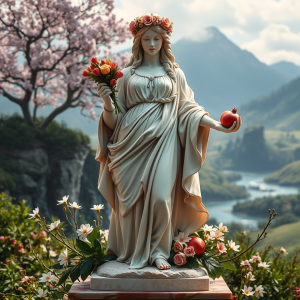
Goddess of Spring and the Underworld
Persephone, a prominent figure in Greek mythology, is best known as the goddess of spring and the queen of the Underworld. Her story is one of duality, reflecting the cyclical nature of life, death, and rebirth. In this article, we will explore the fascinating life of Persephone, her symbols, and her enduring legacy in modern culture.
Who is Persephone?
Persephone is the daughter of Demeter, the goddess of agriculture, and Zeus, the king of the gods. Her beauty captivated many, but it was Hades, the god of the Underworld, who ultimately claimed her as his bride. The myth of Persephone begins with her abduction by Hades, which led to her becoming the queen of the Underworld and a central figure in the ancient Greek understanding of the afterlife.
The Abduction of Persephone
The most famous myth surrounding Persephone is her abduction. While picking flowers in a field, she caught the attention of Hades, who emerged from the earth in his chariot. He took her to his dark realm, where she became his wife. Demeter, devastated by the loss of her daughter, caused the earth to wither and die, leading to a barren winter.
This myth symbolizes the changing seasons. Demeter’s grief represents winter, while the return of Persephone in spring breathes life back into the earth. This cycle of loss and renewal is a powerful aspect of Persephone’s narrative, illustrating the relationship between nature and human emotion.
Persephone’s Dual Role
Persephone’s role as both a spring goddess and the queen of the Underworld highlights her duality. In spring, she is seen as a symbol of growth, fertility, and new beginnings. Flowers bloom, crops grow, and life returns to the earth. However, in the Underworld, she embodies the inevitability of death and the afterlife.
This duality has made Persephone a compelling figure in literature and art. Many artists depict her with symbols like pomegranates, which represent both fertility and the cycle of life and death. Eating the seeds of a pomegranate binds her to the Underworld, emphasizing the connection between her two realms.
Persephone in Modern Culture
Persephone’s influence extends beyond ancient mythology. Today, she symbolizes empowerment and resilience. Many modern interpretations focus on her strength in navigating her dual existence. She is often viewed as a representation of the struggle against oppression and the journey toward self-discovery.
In popular culture, Persephone appears in various forms, from books and movies to fashion and art. Her story resonates with themes of transformation and the balance between light and dark. As more people seek to understand their own complexities, Persephone’s narrative continues to inspire.
Persephone is more than just a goddess of spring and the Underworld; she embodies the complexities of life itself. Her story reflects the themes of growth, loss, and the cyclical nature of existence. As we explore her myths and their meanings, we gain insight into the human experience—embracing both the joy of spring and the inevitability of winter.
By understanding Persephone, we learn to appreciate the beauty in duality and the power of transformation. Whether through ancient texts or modern adaptations, her legacy endures, inviting us to reflect on our own journeys of rebirth and resilience.
-HOME-